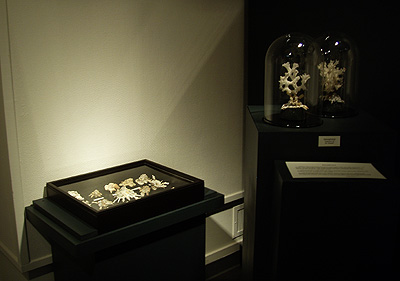
While hapless seekers of natural wonders waited in a mile-long queue to view the rebuilt California Academy of Sciences last Saturday, a much more intimate experience was to be had a few miles to the south at the opening of the "Obsessions" exhibit at the Peninsula Museum of Art in Belmont. The show features a number of private collections, including the Zymoglyphic Museum's Xenophora collection.
Visitors peered closely at these little snails that collect shells, stones, and other objects and attach them to their shells as they grow. Some wondered if they were constructed objects, perhaps a subtle variation on the shell figures sold as seaside tourist souvenirs. Most were amazed that such apparently simple creatures could create such interesting and aesthetically pleasing works. One visitor of a certain age was indignant that she had not known about these animals before, believing that if such an interesting thing existed, surely she would have heard about it by now.
Shell collectors tend to prize shiny, smooth, and rare specimens. They find the "shells that collect shells" idea amusing but there does not seem to be much interest collecting them. Xenophora attract little scientific interest; the Zymoglyphic Museum's Xenophora collection rivals that of the Academy of Sciences itself, which, according to its invertebrate collection catalogue holds only 18 specimens of the family Xenophoridae.
The subtitle of the "Obsessions" exhibit is "Private collections and the history of art museums", highlighting the idea that art museums evolved from the wunderkammern of the European Baroque era. Private collectors amassed curiosities of all kinds. There was a keen interest in natural wonders, and shells in particular. It's in the art museum that the Xenophora can be fully appreciated as natural wonders and and as aesthetic objects with a more than superficial beauty, as well as the conceptual satisfaction of a collection of collectors in a collection of collections.
Thanks to Ruth Waters for including the collection in the show and DeWitt Cheng for the creating the professional display. The show runs until the end of the year.